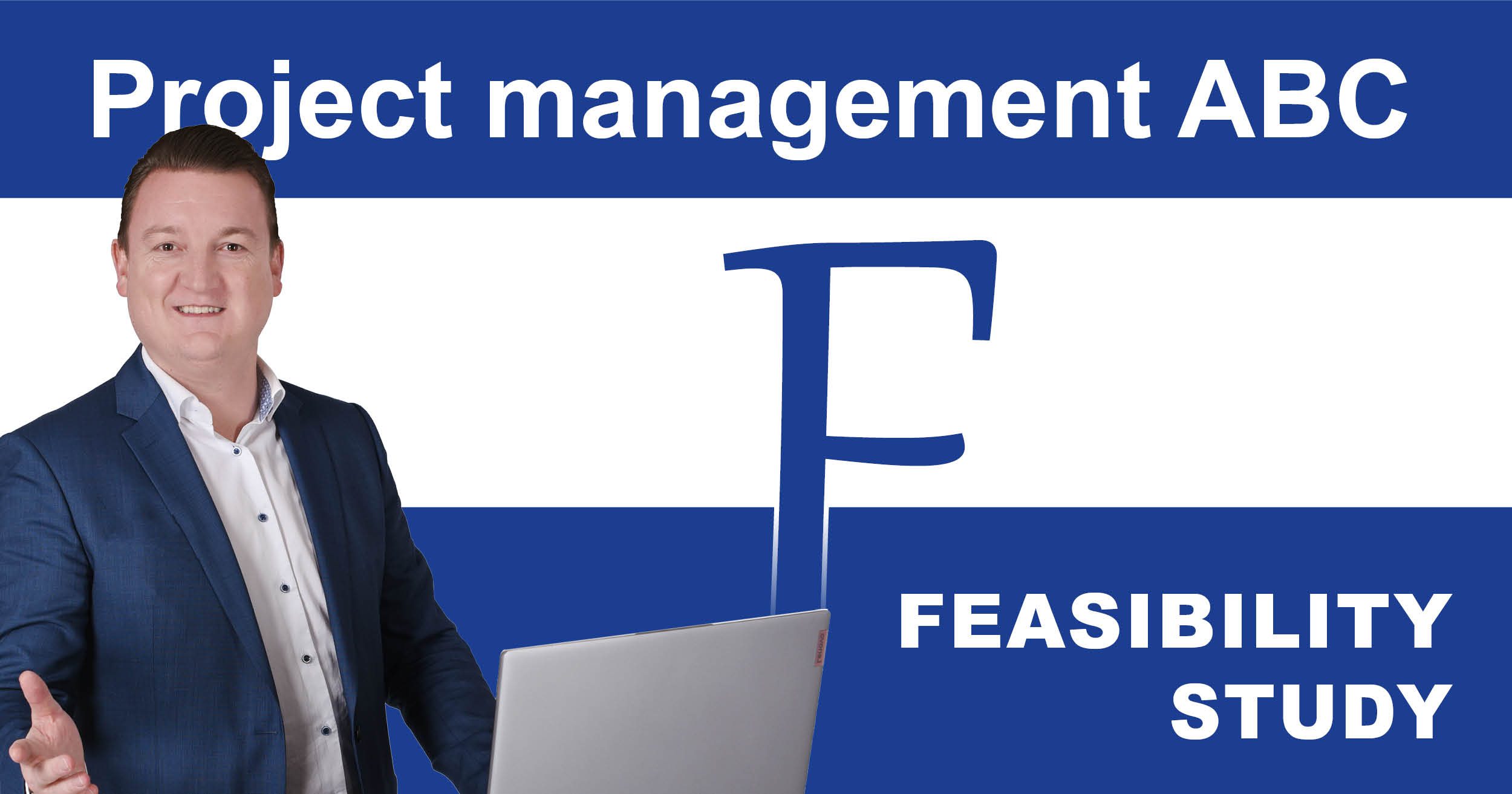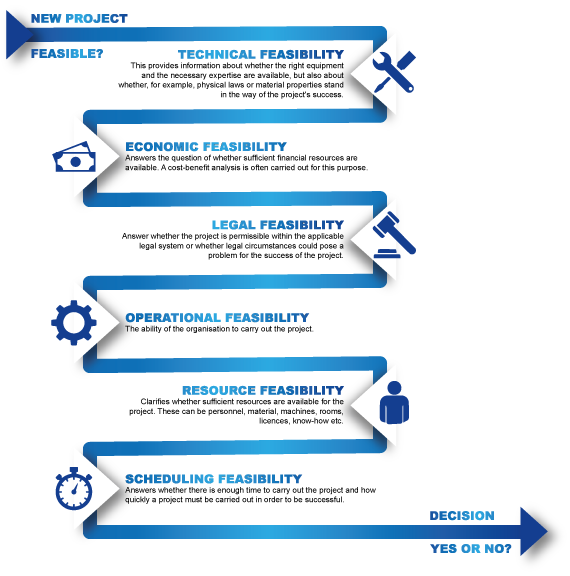Feasibility Study
This is how the Feasibility Study helps you to avoid bad investments and to select the right projects.

A comprehensive, complex project is always very exciting. On the one hand, the implementation promises great success, but on the other hand, there is also a high risk as, for example, a lot of money and time must be invested in the project. So before a manager approves such a large project, he or she should request a feasibility study.
What is a feasibility study?
A feasibility study is carried out before the start of a project. It is used to determine whether a project has a good chance of success and whether it is beneficial for the company. It is therefore an important factor in deciding whether or not to go ahead with a project.
The feasibility study therefore answers the questions:
- Does the company or the team have all the necessary means and resources to complete the project successfully?
- Is it worthwhile for the company to pursue the project idea further?
As part of the feasibility study, various possible projects and solutions are analysed and evaluated. The opportunities and risks for each project are also recorded and the chances of success are assessed so that a clear recommendation can be made for each project as to whether it should be carried out or not.
When should a feasibility study be carried out?
Feasibility studies are particularly helpful for projects that require large investments for implementation, as they reduce the likelihood of putting important resources into the wrong projects.
Useful if:
- misinvestment is to be reduced
- the optimal solution is to be identified or possible alternatives have to be narrowed down
- risks and weak points should be identified
- the market situation should be assessed before the project begins
Not useful if:
- a project is only small in scope
- you already know that the project is feasible
- competitors are already successful with a similar project
Requirements:
A requirement for the study are concrete project objectives, as no study is possible without a clear objective. In addition, the framework conditions of the project should be clear to you.
Components of the feasibility study
-
Technical feasibility: This is about feasibility from a technical point of view, i.e. technical feasibility provides information about whether the right equipment and the necessary expertise are available, but also about whether, for example, physical laws or material properties stand in the way of the project’s success.
Do we have the technical possibilities to realise the project or what is needed to make it possible? -
Economic feasibility: Answers the question of whether sufficient financial resources are available. A cost-benefit analysis is often prepared for this.
Do we have the budget necessary to carry out the project and is it worthwhile? If not, how can we raise funds, reduce costs or make the project profitable? -
Legal feasibility: Answers whether the project is permissible within the applicable legal system or whether legal circumstances could pose a problem for the success of the project.
Are we allowed to carry out the project or would something have to be changed to make it compliant with laws, regulations or guidelines? -
Operational feasibility: The ability of the company to carry out the project.
Can the project be carried out with the existing team or will staff need to be procured? Do we have the necessary competences, powers, responsibilities and is the project management maturity level appropriate? -
Resource feasibility: Clarifies whether sufficient resources are available for the project. These can be personnel, material, machines, rooms, licences, know-how etc.
Do we have sufficient resources? If not, can we procure them? What would it cost? How long would it take? -
Schedule feasibility: Answers whether there is enough time to carry out the project.
Do we have enough time to carry out the project? Are the deadlines realistic?
Contents of a feasibility study
There are countless possibilities, sources of information and tools available to you for carrying out a feasibility study. For example, SWOT analyses, risk analyses, cost-benefit analyses, earned value analyses or profitability analyses. You can also include surveys, interviews, competitive analyses, the scenario technique or even social media trends in your study. Since every project is different, you need to weigh up which options are most suitable. However, the contents of a feasibility study are similar in most cases:
1. Preliminary analysis
Since preparing a feasibility study is very time-consuming, you should first find out whether there are any obvious, insurmountable obstacles that make a feasibility study unnecessary. If major obstacles are already apparent in advance, the feasibility study is probably not worthwhile.
2. Project scope
To define the scope and objectives of the feasibility study, you should first describe the scope of the project. At this stage, you should also define the criteria by which the feasibility of the project will be assessed. At this stage, you should also define the criteria by which the feasibility of the project will be assessed. Furthermore you should also clarify the technical, organisational, resource and schedule feasibility of the project, for example by means of an initial project plan.
3. Financial assessment
Gather information on the expected income and costs of the project so that you can assess its economic feasibility.
4. Market analysis
The market analysis helps you to understand what the market demand for the project outcome is and whether there are any legal obstacles. It also helps you to understand what revenue you can expect, what the risks are and whether there is any demand for your future product or service. Furthermore, in this phase you collect information about the possible target group as well as about the competitive situation. The possible marketing strategy can also be analysed in this phase.
5. Alternative solutions
If you come across potential problems or identify weaknesses during the analysis, you can look for and analyse alternative solutions. In this way you may find alternatives that can still allow the project to be carried out successfully.
6. Evaluate the results
Review the results in an unbiased and holistic way. Are the different solutions feasible? What are the risks in each case?
7. Decision
At the end of a feasibility study, the next steps are recommended. This includes deciding whether the project should be carried out or not. And if it should be carried out, which solution should be chosen.
Advantages
- holistic assessment of the feasibility of a project
- helps to find alternative solutions
- helps to identify risks or obstacles
- basis for the decision for or against a project
- prevents bad investments
- shows the market situation
- the information gathered helps in the later implementation of the project
Disadvantages
- very time-consuming
- cost-intensive
Conclusion
A feasibility study is a useful tool to prevent bad investments and to select the right projects. It also helps in the planning and implementation of projects by highlighting risks and obstacles, but also alternative solutions.
Feasibility analyses are often not carried out due to lack of time and the costs involved. However, at least a small, basic analysis should always be carried out by project managers, as the costs incurred when a project is started and then turns out not to be feasible can be even much higher than the costs of the analysis.
A good project management software can help you prepare a feasibility analysis. With the help of project planning, the software can provide valuable information on schedule feasibility, but also on operational and resource feasibility. In addition, it helps in understanding economic feasibility, as it can be used to estimate the resulting project costs. Project management software with integrated portfolio and programme management with freely definable score maps as well as a risk and opportunity analysis also helps you to decide on the right projects.
Learn more about the project and portfolio management software myPARM:
Would you like to get to know myPARM in a demo presentation? Then make an appointment with us right away!

